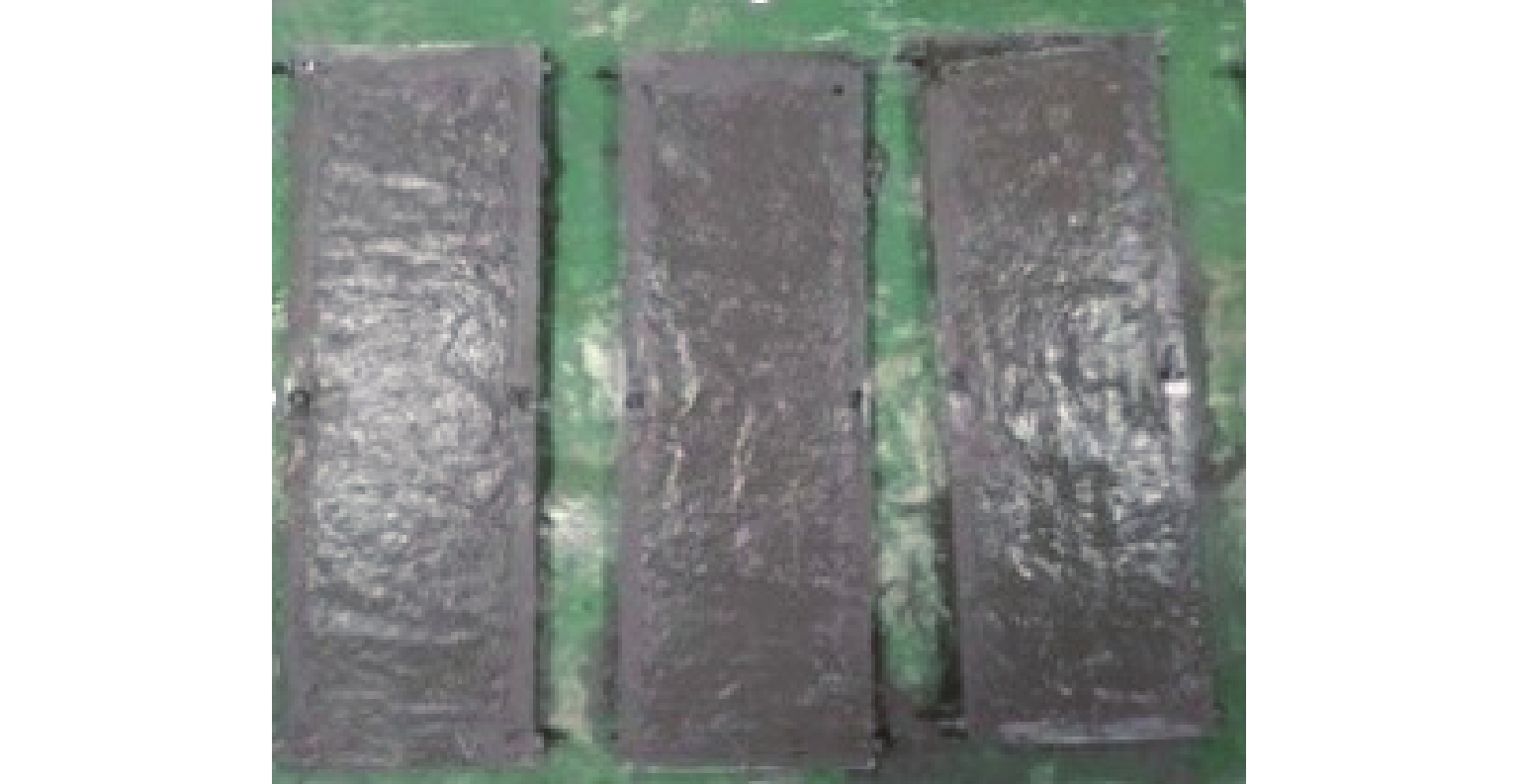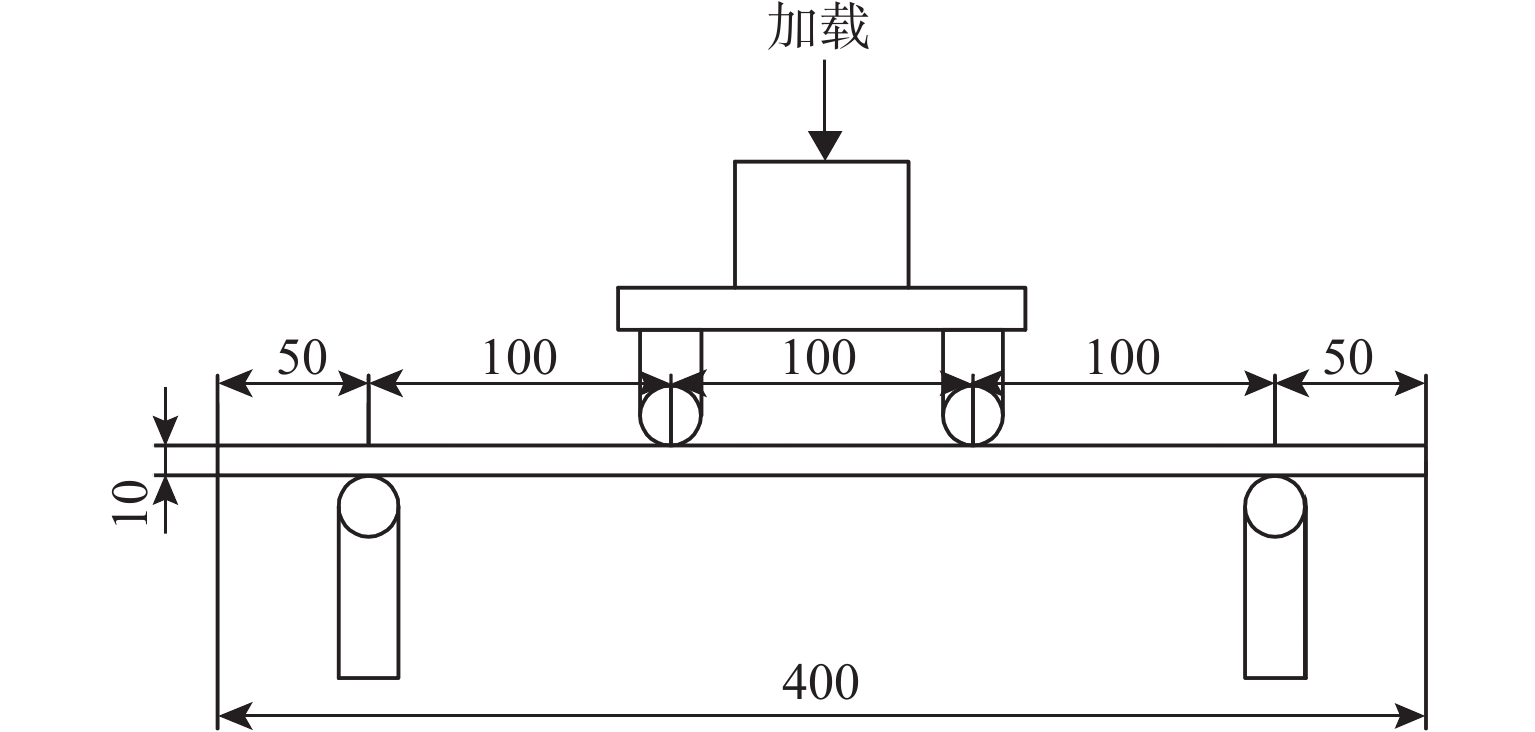Bending Properties of Polypropylene Fiber-Sulfoaluminate Cement-Based Repair Material Using Grey Relation Theory
-
摘要:
为提高水泥基增强复合材料(ECC)经济效益并控制修复周期,以较低成本的聚丙烯纤维和快硬早强硫铝酸盐水泥为关键组材,设计聚丙烯纤维硫铝酸盐水泥基(PP-SACC)修复材料,并探究水胶比、纤维掺量及骨料粒径对修复材料弯曲性能的影响规律,联用灰色关联模型对PP-SACC各工况进行综合评价. 研究结果表明:纤维掺量是影响强度、韧性及裂缝特性最重要的因素,纤维掺量对初裂强度、韧性指标及平均裂缝宽度的影响因子分别为 −0.68、0.79和 −0.98;骨料粒径对裂缝特性同样有明显的影响,石英砂尺寸对平均裂缝宽度的影响因子为 −0.86;水胶比对强度和韧性也有着显著的影响,合理的水胶比更有利于充分发挥纤维的桥连效应;PP-SACC修复材料在具备优异韧性的同时具有挠曲硬化特性.
-
关键词:
- PP纤维-硫铝酸盐水泥基修复材料 /
- 弯曲延性 /
- 挠曲硬化 /
- 改进灰色关联分析
Abstract:To improve the economic benefits of engineered cementitious composite (ECC) and control the repair cycle, the polypropylene fiber-sulfoaluminate cement-based (PP-SACC) repair materials were designed with polypropylene fiber featuring low cost and sulfoaluminate cement featuring fast hardening and early strength employed as the key components. The influence of water-binder ratio, fiber content, and aggregate size on the bending properties of the repair materials was explored. In addition, the grey relation model was used to comprehensively evaluate PP-SACC under all working conditions. The results indicate that the fiber content is the most important factor that affects the strength, toughness, and crack characteristics. The influence factors of fiber content on initial crack strength, toughness index, and average crack width are −0.68, 0.79, and −0.98, respectively. The aggregate size can significantly affect the crack characteristics. The influence factor of quartz sand size on the average crack width is −0.86. The water-binder ratio also greatly affects the strength and toughness, and a reasonable water-binder ratio is beneficial to leverage the bridging effect of the fiber. The PP-SACC repair material has excellent toughness and flexural hardening properties.
-
自20世纪90年代以来,水泥砂浆和水泥混凝土因其具有原材料易得、价格较低、高强耐久性及使用方便等众多优点被广泛应用于建筑、公路、桥梁、港口等领域,并发挥着十分重要的作用[1]. 目前,水泥基材料仍是全世界用量最大,应用最广的建筑材料. 然而,由于水泥基材料自身固有的缺点、在结构中不合理的设计及缺乏维护等因素,我国早期修建的混凝土结构多数已面临加固和修缮的问题. 用于基础设施的维修费用已成为导致结构全生命周期总成本急剧增加的一大难题. 对现有水泥混凝土结构的修复与加固已引起工程界的广泛关注.
修复材料按照成分不同可分为有机类、无机类及有机改性类. 有机类修复材料[2-3]以其高抗渗性、耐腐蚀性、早高强、固化快等特点常应用于路面修补中,但同时也存在修复材料与旧混凝土弹性模量差别大,易与旧混凝土表面脱离掉落的问题[4]. 有机改性类修复材料主要是在水泥基材料中掺入聚合物,通过附着于水化产物上将水化产物与骨料胶结在一起,从而提高黏接性能,增加材料韧性,改善界面区微观结构[5-6]. 但由于目前可供选择的聚合物品种较少,且原材料价格高以及制备工艺的影响,导致大部分普通修补工程无法承受而限制了其应用[7]. 无机类修复材料主要是在普通硅酸盐水泥的基础上,通过调整水胶比或混掺无机纤维[8-10]进行改性. 由于水泥基修复材料与旧混凝土材料性质相近,结构相似,因此,具有良好的变形相容性和体积稳定性,从而作为主要的修复材料应用于修补工程中. 但其同时也存在黏结强度低、收缩率大、脆性大等问题[11]. 纤维作为一种增强复合材料被广泛应用于水泥砂浆体系中,能弥补这些缺陷. 纤维增强的无机类修复材料既能利用纤维改善修复材料的脆性大问题,同时又能提高黏结强度[12]. 自应变硬化水泥基复合材料 (SHCC) 自问世以来,其主要应用之一是修补现有混凝土结构. Xu等[13]发现,工程用水泥基增强复合材料(ECC)作为修复材料能够有效阻止界面裂纹,避免修复系统中常见的失效模式,如剥落、开裂等. ECC修复系统具有更强的延性和更强的吸能能力,并能很好地控制裂缝宽度[14],能够有效降低裂缝宽度,使修复后结构体系内力重分布[15]. Wu等[16]对普通混凝土梁体受弯侧浇注超高韧性水泥基复合材料(UHTCC)制成的修复体系进行试验研究,结果表明,UHTCC的加入提高了修复体系的强度,抑制了裂缝的继续开展.
在修复工程中,快硬、高早强及高韧性对修复材料的制备具有极高的优先级. 由于普通硅酸盐水泥基修复材料的养护期长,延长了修补工期,故不适用于抢修工程. 而通过使用硫铝酸盐水泥基复合材料 (SACC) 可以显著缩短修复工期[17]. 此外ECC材料普遍使用的聚乙烯 (PE) 纤维和聚乙烯醇 (PVA) 纤维价格昂贵,在土木工程中的应用往往受到限制[18]. 而性能优良、价格适宜的聚丙烯(PP)纤维在修复材料中的应用具有极大的潜力.
目前,针对PP纤维增强硫铝酸盐水泥修补材料的研究还相对较少. 对于修补材料性能影响的因素探究尚不清楚、不完备. 张成龙等[19]通过研究PP纤维和PVA纤维混掺,探究了纤维掺量对修补材料各项性能指标的影响规律. 李文强[20]针对矿物掺和料种类、PP纤维掺量及减水剂对硅酸盐水泥基修补材料的影响开展了研究. 何欢等[21]通过掺入PVA纤维增强硫铝酸盐水泥配制ECC材料,探究了PVA最优掺量及其增强机理. 因此,本文综合考虑修复材料对成本、早强和韧性等属性的需求,将硫铝酸盐水泥与聚丙烯纤维的优点结合,通过薄板四点试验对PP-SACC的力学性能和弯曲韧性进行研究,并采用灰色关联理论对材料关键指标的多因素影响开展评价,为进一步推动高性能修复材料的应用提供指导.
1. 配合比设计及试验方案
1.1 配合比设计
1.1.1 原材料
胶凝材料选用42.5快硬硫铝酸盐水泥,其化学组成见表1;微珠化学组成见表2;骨料采用160 μm粒径石英砂及75 μm粒径石英砂粉;外加剂为西卡商用高效减水剂,减水率为45%;拌和水为饮用自来水;PP纤维相关性能参数见表3,纤维体积掺量取2.5%和3.0%.
表 1 快硬硫铝酸盐水泥的化学成分组成Table 1. Chemical compositions of fast-hardening sulfoaluminate cement% 成分 质量分数 成分 质量分数 CaO 47.4 SO3 12.3 Al2O3 23.5 MgO 4.4 SiO2 10.1 Fe2O3 2.3 表 2 微珠化学成分组成Table 2. Chemical compositions of cenosphere% 成分 质量分数 成分 质量分数 SiO2 56.6 Fe2O3 5.3 CaO 4.8 Na2O 1.4 MgO 1.3 K2O 3.3 Al2O3 26.5 SO3 0.8 表 3 PP纤维物性参数Table 3. Physical properties of PP fibers参数 断裂强度/MPa 当量直径/μm 纤维长度/mm 初始弹性模量/GPa 断裂伸长率/% 取值 630 25.46 12 7.1 25.2 1.1.2 配合比选择
为探究不同水胶比对弯曲性能的影响,选择0.25、0.30、0.40 3种水胶比设计PP-SACC,同时固定各工况砂胶比为0.36. 通过掺入胶凝材料0.5%的柠檬酸适当延长初凝时间. 同时混入20%微珠降低混凝土的黏性,减少用水量和搅拌时间. 各工况容重为
2 072 kg/m3左右. 各工况修复材料去除纤维后的基体流动度及修复材料流动度见表4. 流动测试方法参考《水泥胶砂流动度测定方法》(GB/T 2419—2005)[22].表 4 PP-SACC各工况基本配合比Table 4. Mix proportions of PP-SACC under all working conditions试件编号 水胶比 骨料粒径/μm 纤维掺量/% 修复材料流动度/mm 基体流动度/mm A1-2.5 0.40 75 2.5 216 173 A1-3.0 0.40 75 3.0 196 A-2.5 0.40 160 2.5 211 230 A-3.0 0.40 160 3.0 183 B1-2.5 0.30 75 2.5 181 119 B1-3.0 0.30 75 3.0 165 B-2.5 0.30 160 2.5 173 123 B-3.0 0.30 160 3.0 137 C1-2.5 0.25 75 2.5 162 104 C1-3.0 0.25 75 3.0 150 C-2.5 0.25 160 2.5 171 118 C-3.0 0.25 160 3.0 155 1.2 试验方案
1.2.1 搅拌成型
将纤维、水泥、微珠、石英砂等干料混合均匀且纤维均匀分散后,加入缓凝剂、减水剂及配合比用水. 参照规范[23]成型胶砂试件,如图1所示. 装模后立刻覆盖一层不透水薄膜,防止水分散失过快. 24 h后拆模并放入标准养护室养护至试验龄期.
1.2.2 薄板四点弯曲试验
为更直观地展现纤维增强水泥基复合材料的弯曲韧性,本次试验设计的试件尺寸参考文献[24]并加以改进,成型了400 mm × 100 mm × 10 mm的薄板试件,试验龄期为14 d,在10 kN的微机万能电子试验机上进行试验,加载速率为0.5 mm/min. 利用荷载传感器和直线位移传感器(LVDT)分别测量弯曲荷载和跨中挠度. 各工况弯曲性能指标在剔除异常值后得出. PP-SACC薄板四点弯曲如图2所示.
2. 试验结果与讨论
2.1 荷载-挠度曲线分析
各组四点弯曲试验的荷载-挠度见图3所示.
参考《纤维混凝土试验方法标准》(CECS 13—2009)[25],将荷载-挠度曲线中第1个非线性点定义为初裂点,该点对应的挠度及荷载分别定义为初裂挠度(δc)和初裂荷载(Pc). 各工况抗折强度的计算参考《水泥胶砂强度检验方法(ISO法)》(GB/T 17671—2021)[23]. 在剔除与3个强度平均值相差超过10%的异常值后,将剩余强度值再平均后求出. 由于该初裂强度值接近混凝土基体开裂时的强度值,故初裂强度能够有效表征材料基体的强度. 从图3中可以看出:PP-SACC在达到初裂荷载值之前,上升段接近于线性状态,试件跨中底部出现第1条初始裂缝时,荷载-挠度曲线出现第1次波峰,即初裂荷载值;随后,由于初始裂缝处PP纤维的桥接作用,荷载-挠度曲线开始回升,部分工况开始呈现出明显的挠曲硬化现象,达到极限承载力后,PP纤维逐渐被拉出,承载力开始下降并最终破坏.
2.2 弯曲性能分析
通过统计各工况的3个试件得到初裂强度值,见表5. 总体上初裂强度值随水胶比降低而逐渐提高;纤维掺量和骨料粒径的变化对初裂强度值的影响规律与水胶比有较强相关性;骨料粒径的变化对水胶比0.40和0.25各组的初裂强度值影响较小,最大在A-3.0组中;提高骨料粒径降低了A-3.0组14.6%的初裂强度;在水胶比为0.3时,提高骨料粒径增加了初裂强度,在B1-2.5组及B1-3.0组中,骨料粒径的增大使初裂强度分别提高28.7%和10.1%.
表 5 各工况初裂强度值Table 5. Initial crack strengths under all working conditionsMPa 编号 初裂强度 编号 初裂强度 A1-2.5 4.56 B-2.5 8.74 A1-3.0 5.06 B-3.0 6.31 A-2.5 4.59 C1-2.5 8.44 A-3.0 4.32 C1-3.0 8.32 B1-2.5 6.79 C-2.5 8.44 B1-3.0 5.73 C-3.0 8.14 在水胶比为0.25及0.40时,纤维掺量的变化对初裂强度的影响很小,最大在A1-2.5组中,提高纤维掺量降低了A1-2.5组11.0%的初裂强度;而当水胶比为0.30时,纤维掺量的变化对初裂强度值影响较大,随着B-2.5、B1-2.5组中纤维掺量的提高,初裂强度值分别下降了27.8%、15.6%. 事实上,由于水胶比对砂浆的流动性影响较大,流动性随着水胶比的增大而增大,当水胶比较大时,聚丙烯纤维被基体润湿,并与纤维形成良好的键合,然而,高水胶比同时也会减少PP纤维与基体之间的摩擦黏结. 在流动度较低时,由于基体量不足以使纤维充分润湿并黏结,也会导致纤维黏结性能有所下降[26].
在试验结束后,从加载装置上取下试件,通过便携式显微镜对每块试件的裂缝宽度进行统计. 每条裂缝统计3~6处裂缝宽度,各工况数据均来自3块试件的平均值. 各工况平均裂缝宽度及根数见表6. 从表6可以看出:各组裂缝发展情况相差较大,但往往出现裂缝越多的工况其挠曲硬化现象也更为明显,挠曲硬化阶段长;裂缝数越少时,挠曲硬化阶段也就越短,主裂缝出现的可能性越高. 弯曲韧性指标是评价材料弯曲性能的重要指标之一,根据试验测量结果,参考规范[25]对韧性指标定义:以δc对应的荷载-挠度曲线下面积A0为基准,分别取3.0δc、5.5δc、10.5δc、20.5δc时的挠度对应荷载-挠度曲线下的面积与A0的比值为韧性指标,并依次记为I5、I10、I20、I40,反映了指定挠度时PP-SACC的耗能和开裂时耗能之间的比值. 根据上述定义计算得到PP-SACC的韧性指标见表7.
表 6 各工况四点弯曲开裂行为Table 6. Cracking behavior of four-point bending under all working conditions编号 平均裂缝
宽度/mm根数/根 编号 平均裂缝
宽度/mm根数/根 A1-2.5 0.240 6.33 B-2.5 0.230 6.00 A1-3.0 0.140 14.67 B-3.0 0.210 5.33 A-2.5 0.190 5.67 C1-2.5 0.190 7.33 A-3.0 0.470 1.67 C1-3.0 0.490 3.00 B1-2.5 0.290 4.67 C-2.5 0.230 8.33 B1-3.0 0.190 11.67 C-3.0 0.250 3.67 表 7 各工况弯曲韧性指标Table 7. Toughness indexes under all working conditions编号 I5 I10 I20 I40 A1-2.5 3.82 7.49 17.14 33.13 A1-3.0 4.11 8.15 16.91 35.8 A-2.5 4.43 8.99 18.99 39.88 A-3.0 4.32 8.56 18.31 38.17 B1-2.5 3.74 7.14 15.79 32.92 B1-3.0 4.33 8.77 18.65 40.29 B-2.5 3.80 7.59 15.84 33.96 B-3.0 4.22 8.49 17.76 38.40 C1-2.5 4.12 8.23 17.30 39.11 C1-3.0 3.58 7.14 17.05 36.97 C-2.5 3.91 7.46 16.49 32.81 C-3.0 3.72 7.55 17.92 29.69 从表7可以看出:韧性指标I40从大到小依次是B1-3.0、A-2.5、C-2.5、C1-3.0、B-3.0、A-3.0、C1-3.0、A1-3.0、B-2.5、A1-2.5、B1-2.5、C-2.5、C-3.0,其中,B1-3.0表现出最高的韧性性能;对比表6,部分在弯曲试验中表现出脆性破坏且裂缝根数较少的工况,如C1-3.0,其韧性指标大于试验中表现出延性破坏且裂缝根数多的工况,如A1-3.0. 正是由于弯曲性能受较为复杂的材料特性控制,特别是在挠曲硬化水泥基材料中[26]. 下文将利用灰色关联理论进一步分析各因素对弯曲性能的影响. 灰色关联度分析法一般用于解决不同因素对某一变量有无影响,孰大孰小的定性问题. 邓聚龙[27]提出的灰色关联度模型中规定灰色关联度为0~1的一个实数值,但并不能反映因素的正、负相关关系. 文献[28]对灰色关联度的正负性问题进行了探讨;文献[29]中提出的一种改进的关联度,通过考虑对应时段的斜率比值,来反映序列之间的相关程度.
操作方法如下:
设比较矩阵和参考矩阵[30]分别为
X1=(x1(1),x1(2),⋯,x1(k),⋯x1(n)), (1) X0=(x0(1),x0(2),⋯,x0(k),⋯x0(n)). (2) 设X1或X0在区间[k−1, k]上的斜率α=x(k+1)−x(k),k=1,2,…,n. X0和X1斜率组成的矩阵分别表示为
K0=(k01,k02,⋯,k0(n−1)), (3) K1=(k11,k12,⋯,k1(n−1)). (4) X0和X1各个对应时段的斜率比值所组成的矩阵表示为
K01=(k01/k11,k02/k12,⋯,k0(n−1)/k1(n−1)). (5) 定义K0的变异系数及K01的广义变异系数分别为
δ(X0)=S0¯K0, (6) ξ(K01)=S01¯K01, (7) 式中:¯K0=1n−1n−1∑j=1k0j,S0=√1n−2n−1∑j=1(k0j−¯K0)2,¯K01=1n−1n−1∑j=1(k0j/k1j),S01=√1n−2n−1∑j=1(k0j/k1j−1)2.
则X0和X1的灰色关联度为
γ(X0,X1)={1+|δ(X0)|1+|δ(X0)|+|ξ(X0/X1)|,¯K01⩾ (8) 在韧性指标I5、I10、I20、I40中,鉴于各个指标含义趋势相同,仅取韧性指标I40作为研究对象,其余指标不做赘述. 依次设定韧性指标I40、平均裂缝宽度、初裂强度值为母序列,水胶比、骨料粒径、纤维掺量为子序列. 各影响因子对弯曲性能指标的关联度如表8所示.
表 8 反应弯曲性能指标关联度Table 8. Correlation of bending property indexes影响因子 I40 平均裂缝宽度 初裂强度值 水胶比 0.7321 0.6531 − 0.8558 骨料粒径 − 0.2364 − 0.8583 − 0.2188 纤维掺量 0.7947 − 0.9843 − 0.6774 从表8可以看出:骨料粒径及纤维掺量对平均裂缝宽度的影响最大,均呈负相关;水胶比对平均裂缝宽度的影响相对较小,呈正相关;对韧性指标I40影响最大的是纤维掺量,其次是水胶比,均呈正相关,骨料粒径的影响很小;对初裂强度值影响最大的是纤维掺量,其次是水胶比,骨料粒径的影响较小;不同的是3个因素均与初裂强度值呈负相关.
事实上,水胶比越大,PP-SACC基体的用水量越大,和易性得到改善的同时纤维能够被基体充分包裹,但同样也减少了PP纤维与基体之间的摩擦黏结,使纤维的桥接作用降低,从而影响了PP-SACC的弯曲性能. PP纤维掺量对材料强度的影响是辩证的,随着水胶比的降低,纤维的拔出将会消耗更多的能量. PP纤维需要克服较大的摩擦力,最终被拉出,从而增加断裂能. 当水胶比进一步降低时,由于PP纤维在流动性相对较低的基体中不易分散,纤维之间的相互缠绕. 结团导致了试样初始缺陷,进而影响试件的强度.
3. 灰色关联优选
王建明[31]针对评价指标多、决策信息不完全的决策问题,构建一种多目标决策集成灰色关联决策模型;周小川[32]基于模糊-层次分析法以及灰色关联度法,提出一种应用于铁路线路选择的决策思路. 由于指标赋权在主观决策的偏好及标度设定的固有误差,往往导致判断矩阵Y= ({a}_{gh}) 不具备完全一致性,且有αgh≈wg/wh,其中,wg和wh分别为第g个因素和第h个因素的真实权重. 因此,通过判断矩阵求解出权向量,然后对矩阵进行一致性检验. 本文采用MATLAB的eig(Y)指令,直接求解矩阵的特征值和对应的特征向量. 由于指标之间相对重要程度的模糊性导致所建立的判断矩阵Y往往不能够满足一致性条件,因此,有必要通过检验矩阵的一致性程度来反映特征向量与真实权向量的贴近度. 定义衡量判断矩阵一致性的比例指标为
C_{\mathrm{CR}}=\frac{{\lambda }_{\max}-n}{\left(n-1\right)R_{\mathrm{RI}}} \text{,} (9) 式中: {\lambda }_{\mathrm{m}\mathrm{a}\mathrm{x}} 为判断矩阵的最大特征根,RRI为平均随机一致性指标.
本文判断矩阵为3阶矩阵,故RRI=0.58. 当CCR≤
0.1000 时,认为判断矩阵具有满意一致性. 乘以确定的各指标权重,计算各组理想最佳组合的灰色关联度G(X1, X0),根据公式Hq= G(X1, X0) wi (wi为第i个因素),得到灰色关联度矩阵H,灰色关联度矩阵能够综合评价各组合的效果. 由于各工况在韧性性能及强度上的表现有区别. PP-SACC作为修复材料,要求其高韧性的同时还需要保证足够的强度,各组材料的韧性指标I40、平均裂缝宽度、初裂强度值组合形成了12组3个指标参数的弯曲性能如表9所示.表 9 PP-SACC各工况性能测试结果汇总Table 9. Test results of PP-SACC under all working conditions组号 I40 平均裂缝
宽度/mm初裂强度
值/MPaA1-2.5 33.13 0.237 4.56 A1-3.0 35.80 0.137 5.06 A-2.5 39.88 0.194 4.59 A-3.0 38.17 0.475 4.32 B1-2.5 32.92 0.292 6.79 B1-3.0 40.29 0.193 5.73 B-2.5 33.96 0.233 8.74 B-3.0 38.40 0.206 6.31 C1-2.5 39.11 0.193 8.44 C1-3.0 36.97 0.491 8.32 C-2.5 32.81 0.231 8.44 C-3.0 29.69 0.250 8.14 利用层次分析法计算权重α,依据文献[32]的计算过程和步骤,构建指标的判断矩阵为
\boldsymbol{Y}=\left[\begin{array}{ccc}1.00& 4.00& 7.00\\ 0.25& 1.00& 4.00\\ 0.14& 0.25& 1.00\end{array}\right] . 求得各指标权重α=[
0.6955 0.2290 0.0754 ]T,最大特征根λmax=3.0764 ,然后进行一致性检验,CCR=0.0583 <0.1000 ,Y的不一致性程度在容许范围内. 汇总样本结果,并构建12 × 3的样本矩阵A,进行初始化处理,得到初始矩阵C,并确定理想评价指标[1.2161 0.5004 1.9167 ],计算各组指标集合与理想指标集合的关联度,从而确定关联系数矩阵为\boldsymbol{R}=\left[\begin{array}{ccc}0.775\;8& 0.638\;9& 0.449\;3\\ 0.846\;6& 1.000\;0& 0.481\;0\\ 0.983\;7& 0.756\;9& 0.451\;1\\ 0.921\;2& 0.334\;0& 0.435\;6\\ 0.770\;8& 0.532\;4& 0.636\;3\\ 1.000\;0& 0.760\;4& 0.531\;2\\ 0.796\;5& 0.648\;1& 1.000\;0\\ 0.929\;1& 0.719\;5& 0.584\;0\\ 0.954\;5& 0.759\;1& 0.919\;2\\ 0.881\;9& 0.333\;3& 0.890\;4\\ 0.768\;1& 0.653\;2& 0.919\;2\\ 0.700\;4& 0.610\;7& 0.850\;4 \end{array}\right] . 结合权重指标,计算得到H=[0.720 0.854 0.892 0.753 0.706 0.910 0.778 0.855 0.907 0.757 0.753 0.691]T,根据最大值优化原理,各组的评估排序从大到小依次为B1-3.0、C1-2.5、A-2.5、B-3.0、A1-3.0、B-2.5、C1-3.0、C-2.5、A-3.0、A1-2.5、B1-2.5、C-3.0. 由此可以看出,B1-3.0组材料综合韧性、开裂行为及强度性能最佳.
4. 早期收缩性能
收缩性能是PP-SACC修复材料成功应用的关键控制因素. 因此,为探究PP-SACC的早期收缩性能,根据规范JGJ/T70—2009[33]开展PP-SACC砂浆收缩试验. 所有工况收缩应变值均在剔除异常值后通过计算均值取得. 各工况不同龄期下收缩变形如图4所示.
从图4可以看出:随着龄期的增长,各工况收缩应变持续增大,并在6 d龄期左右时达到最大峰值;随着龄期的继续增长,各工况收缩应变开始稳定;在9 d龄期时,各工况收缩应变均在800 με以内.
5. 结 论
本文通过开展PP-SACC修复材料薄板四点弯曲试验,探究不同水胶比、PP纤维掺量及骨料粒径对PP-SACC材料弯曲性能的影响,得到以下结论:
1) 总体上初裂强度值随水胶比降低而逐渐提高;在水胶比为0.25和0.40的各工况中,骨料粒径和纤维掺量的变化对初裂强度的影响较小. 而在水胶比0.30的各工况中,兼顾工作性和强度,骨料粒径的增大提高了初裂强度,而纤维掺量的提高则显著地降低了初裂强度.
2) 基于改进灰色关联度理论开展不同因素对PP-SACC弯曲性能影响的研究. 纤维掺量和骨料粒径是影响平均裂缝宽度最显著的因素,而水胶比的影响较小. 对弯曲韧性性能影响最大的是纤维掺量,其次是水胶比,而骨料粒径影响最小. 纤维掺量和水胶比对强度的影响最大,而骨料粒径的影响较小.
3) 优化的PP-SACC工况中,薄板试件在加载期间表现出明显的挠曲硬化现象,小间距、窄宽度的裂纹随荷载增加而发育和扩展. 试验结束后,尽管试件产生较大的弯曲变形,但仍保持良好的完整性.
4) 基于灰色关联优选 “水胶比0.30 + 纤维掺量3.0% + 骨料粒径75 μm”的B1-3组兼顾强度和韧性,综合性能最好. 同时通过早期收缩试验验证了其作为修复材料的使用性能.
-
表 1 快硬硫铝酸盐水泥的化学成分组成
Table 1. Chemical compositions of fast-hardening sulfoaluminate cement
% 成分 质量分数 成分 质量分数 CaO 47.4 SO3 12.3 Al2O3 23.5 MgO 4.4 SiO2 10.1 Fe2O3 2.3 表 2 微珠化学成分组成
Table 2. Chemical compositions of cenosphere
% 成分 质量分数 成分 质量分数 SiO2 56.6 Fe2O3 5.3 CaO 4.8 Na2O 1.4 MgO 1.3 K2O 3.3 Al2O3 26.5 SO3 0.8 表 3 PP纤维物性参数
Table 3. Physical properties of PP fibers
参数 断裂强度/MPa 当量直径/μm 纤维长度/mm 初始弹性模量/GPa 断裂伸长率/% 取值 630 25.46 12 7.1 25.2 表 4 PP-SACC各工况基本配合比
Table 4. Mix proportions of PP-SACC under all working conditions
试件编号 水胶比 骨料粒径/μm 纤维掺量/% 修复材料流动度/mm 基体流动度/mm A1-2.5 0.40 75 2.5 216 173 A1-3.0 0.40 75 3.0 196 A-2.5 0.40 160 2.5 211 230 A-3.0 0.40 160 3.0 183 B1-2.5 0.30 75 2.5 181 119 B1-3.0 0.30 75 3.0 165 B-2.5 0.30 160 2.5 173 123 B-3.0 0.30 160 3.0 137 C1-2.5 0.25 75 2.5 162 104 C1-3.0 0.25 75 3.0 150 C-2.5 0.25 160 2.5 171 118 C-3.0 0.25 160 3.0 155 表 5 各工况初裂强度值
Table 5. Initial crack strengths under all working conditions
MPa 编号 初裂强度 编号 初裂强度 A1-2.5 4.56 B-2.5 8.74 A1-3.0 5.06 B-3.0 6.31 A-2.5 4.59 C1-2.5 8.44 A-3.0 4.32 C1-3.0 8.32 B1-2.5 6.79 C-2.5 8.44 B1-3.0 5.73 C-3.0 8.14 表 6 各工况四点弯曲开裂行为
Table 6. Cracking behavior of four-point bending under all working conditions
编号 平均裂缝
宽度/mm根数/根 编号 平均裂缝
宽度/mm根数/根 A1-2.5 0.240 6.33 B-2.5 0.230 6.00 A1-3.0 0.140 14.67 B-3.0 0.210 5.33 A-2.5 0.190 5.67 C1-2.5 0.190 7.33 A-3.0 0.470 1.67 C1-3.0 0.490 3.00 B1-2.5 0.290 4.67 C-2.5 0.230 8.33 B1-3.0 0.190 11.67 C-3.0 0.250 3.67 表 7 各工况弯曲韧性指标
Table 7. Toughness indexes under all working conditions
编号 I5 I10 I20 I40 A1-2.5 3.82 7.49 17.14 33.13 A1-3.0 4.11 8.15 16.91 35.8 A-2.5 4.43 8.99 18.99 39.88 A-3.0 4.32 8.56 18.31 38.17 B1-2.5 3.74 7.14 15.79 32.92 B1-3.0 4.33 8.77 18.65 40.29 B-2.5 3.80 7.59 15.84 33.96 B-3.0 4.22 8.49 17.76 38.40 C1-2.5 4.12 8.23 17.30 39.11 C1-3.0 3.58 7.14 17.05 36.97 C-2.5 3.91 7.46 16.49 32.81 C-3.0 3.72 7.55 17.92 29.69 表 8 反应弯曲性能指标关联度
Table 8. Correlation of bending property indexes
影响因子 I40 平均裂缝宽度 初裂强度值 水胶比 0.7321 0.6531 − 0.8558 骨料粒径 − 0.2364 − 0.8583 − 0.2188 纤维掺量 0.7947 − 0.9843 − 0.6774 表 9 PP-SACC各工况性能测试结果汇总
Table 9. Test results of PP-SACC under all working conditions
组号 I40 平均裂缝
宽度/mm初裂强度
值/MPaA1-2.5 33.13 0.237 4.56 A1-3.0 35.80 0.137 5.06 A-2.5 39.88 0.194 4.59 A-3.0 38.17 0.475 4.32 B1-2.5 32.92 0.292 6.79 B1-3.0 40.29 0.193 5.73 B-2.5 33.96 0.233 8.74 B-3.0 38.40 0.206 6.31 C1-2.5 39.11 0.193 8.44 C1-3.0 36.97 0.491 8.32 C-2.5 32.81 0.231 8.44 C-3.0 29.69 0.250 8.14 -
[1] 李梦杰. 聚合物混凝土在路面破损快速维修的试验研究[D]. 郑州: 郑州大学,2021. [2] 龙方来. 聚合物改性水泥混凝土路面薄层快速修补材料配比研究[D]. 郑州: 郑州大学,2016. [3] 王亮,杜国庆,高华,等. 渗透类防水防腐涂覆体系在桥梁修复中的应用[J]. 中国建筑防水,2020(12): 36-39.WANG Liang, DU Guoqing, GAO Hua, et al. Application of capillary waterproofing and anti-corrosive coating system in bridge repairing[J]. China Building Waterproofing, 2020(12): 36-39. [4] 钟世云,袁华. 聚合物在混凝土中的应用[M]. 北京:化学工业出版社,2003:8 [5] CHEN K Y, WU D Z, YI M, et al. Mechanical and durability properties of metakaolin blended with slag geopolymer mortars used for pavement repair[J]. Construction and Building Materials, 2021, 281(2): 122566.1-122566.26. [6] SADRMOMTAZI A, KHOSHKBIJARI R K. Bonding durability of polymer-modified concrete repair overlays under freeze–thaw conditions[J]. Magazine of Concrete Research, 2017, 69(24): 1268-1275. doi: 10.1680/jmacr.17.00014 [7] SIDDIKA A, HAJIMOHAMMADI A, MAMUN M A A, et al. Waste glass in cement and geopolymer concretes: a review on durability and challenges[J]. Polymers, 2021, 13(13): 2071.1-2071.26. [8] 陈全胜,侯圣均,江传彬,等. PVA纤维水泥基复合材料抗冲蚀磨损性能试验研究[J]. 西南交通大学学报,2023,58(1): 150-158.CHEN Quansheng, HOU Shengjun, JIANG Chuanbin, et al. Experimental study on hydro-abrasion performance of polyvinyl alcohol fiber cementitious composites[J]. Journal of Southwest Jiaotong University, 2023, 58(1): 150-158. [9] AFROUGHSABET V, BIOLZI L, OZBAKKALOGLU T. High-performance fiber-reinforced concrete: a review[J]. Journal of Materials Science, 2016, 51(14): 6517-6551. doi: 10.1007/s10853-016-9917-4 [10] CAO Q, LI H, LIN Z B. Effect of active confinement on compressive behavior of GFRP-confined expansive concrete under axial cyclic loading[J]. ACI Structural Journal, 2020, 117(1): 207-216. [11] BELAIDI A S E, BENABED B, SOUALHI H. Physical and mechanical properties of concrete repair materials in dry and hot-dry environment[J]. Journal of Adhesion Science and Technology, 2015, 29(6): 543-554. doi: 10.1080/01694243.2014.998001 [12] SOUPIONIS G, GEORGIOU P, ZOUMPOULAKIS L. Polymer composite materials fiber-reinforced for the reinforcement/repair of concrete structures[J]. Polymers, 2020, 12(9): 2058.1-2058.14. [13] XU S L, WANG N, ZHANG X F. Flexural behavior of plain concrete beams strengthened with ultra high toughness cementitious composites layer[J]. Materials and Structures, 2012, 45(6): 851-859. doi: 10.1617/s11527-011-9803-0 [14] 徐世烺,王楠,尹世平. 超高韧性水泥基复合材料加固钢筋混凝土梁弯曲控裂试验研究[J]. 建筑结构学报,2011,32(9): 115-122.XU Shilang, WANG Nan, YIN Shiping. Experimental study on flexural characteristics of RC beams strengthened with post-poured ultra high toughness cementitious composites[J]. Journal of Building Structures, 2011, 32(9): 115-122. [15] 徐世烺,王楠. 后浇UHTCC加固既有混凝土复合梁的弯曲控裂性能[J]. 中国公路学报,2011,24(3): 36-43. doi: 10.3969/j.issn.1001-7372.2011.03.006XU Shilang, WANG Nan. Flexural crack control performance of existing concrete composite beam reinforced by post-poured UHTCC[J]. China Journal of Highway and Transport, 2011, 24(3): 36-43. doi: 10.3969/j.issn.1001-7372.2011.03.006 [16] WU C, LI V C. Thermal-mechanical behaviors of CFRP-ECC hybrid under elevated temperatures[J]. Composites Part B: Engineering, 2017, 110: 255-266. doi: 10.1016/j.compositesb.2016.11.037 [17] 冯虎,刘光辉,毕永涛,等. 微细钢纤维快硬高强硫铝酸盐水泥砂浆与钢筋黏结性能研究[J]. 施工技术,2019,48(2): 121-125.FENG Hu, LIU Guanghui, BI Yongtao, et al. Bond properties between micro-steel-fiber reinforced fast hardening high strength sulphoaluminate cement mortar and steel bar[J]. Construction Technology, 2019, 48(2): 121-125. [18] 田俊. 超高韧性水泥基复合材料加固混凝土结构的界面力学性能与耐久性能研究[D]. 南京:东南大学,2017. [19] 张成龙,刘漪,张明. PP/PVA纤维增强硫铝酸盐水泥基快速修补材料试验研究[J]. 硅酸盐通报,2021,40(7): 2174-2183.ZHANG Chenglong, LIU Yi, ZHANG Ming. PP/PVA fiber reinforced sulphoaluminate cement-based rapid repair material[J]. Bulletin of the Chinese Ceramic Society, 2021, 40(7): 2174-2183. [20] 李文强. 纤维水泥基修补材料在桥墩冲刷破坏中的应用研究[D]. 成都: 西南交通大学,2018. [21] 何欢,杨荣俊,文俊强,等. PVA纤维增强快硬硫铝酸盐水泥基ECC材料性能的研究[J]. 硅酸盐通报,2019,38(5): 1484-1490,1496.HE Huan, YANG Rongjun, WEN Junqiang, et al. Study on the rapid hardening sulphoaluminate-based engineered cementitious composites reinforced with PVA fiber[J]. Bulletin of the Chinese Ceramic Society, 2019, 38(5): 1484-1490,1496. [22] 中华人民共和国国家质量监督检验检疫总局,中国国家标准化管理委员会. 水泥胶砂流动度测定方法:GB/T 2419—2005[S]. 北京: 中国标准出版社,2005. [23] 国家市场监督管理总局,国家标准化管理委员会. 水泥胶砂强度检验方法(ISO法): GB/T 17671—2021[S]. 北京: 中国标准出版社,2021. [24] 蔡向荣. 超高韧性水泥基复合材料基本力学性能和应变硬化过程理论分析[D]. 大连:大连理工大学,2010. [25] 中国工程建设标准化协会. 纤维混凝土试验方法标准:CECS 13—2009[S]. 北京:中国计划出版社,2010. [26] CONG L, LI V, CHRISTOPHER K Y L. Flaw characterization and correlation with cracking strength in Engineered Cementitious Composites (ECC)[J]. Cement & Concrete Research, 2018, 107: 64-74. [27] 邓聚龙. 灰色控制系统[J]. 华中工学院学报,1982(3): 9-18. [28] QI Z F, HUANG Z Y, LI H, et al. Study of flexural response in strain hardening cementitious composites based on proposed parametric model[J]. Materials, 2018, 12(1): 113.1-113.14. [29] 李京坤,程进章,郭辉娟,等. 基于灰色关联度的超临界流体换热系数影响因素研究[J]. 湖北电力,2022,46(1): 58-64.LI Jingkun, CHENG Jinzhang, GUO Huijuan, et al. Study on influencing factors of supercritical fluid heat transfer coefficient based on grey correlation degree[J]. Hubei Electric Power, 2022, 46(1): 58-64. [30] 阴悦. 复合材料目视损伤检验影响因素的灰色关联分析[D]. 南京: 南京航空航天大学,2017. [31] 王建明. 多目标模糊识别优化决策理论与应用研究[D]. 大连: 大连理工大学,2004. [32] 周小川. 模糊层次分析法和灰色关联度在铁路方案决策中的应用[D]. 成都: 西南交通大学,2011. [33] 中华人民共和国住房和城乡建设部. 建筑砂浆基本性能试验方法标准:JGJ/T 70—2009[S]. 北京: 中国建筑工业出版社,2009. -





 下载:
下载:





 下载:
下载:








